

Just as different seats in a theater provide different perspectives on a performance, different Earth orbits give satellites varying perspectives, each valuable for different reasons. Some seem to hover over a single spot, providing a constant view of one face of the Earth, while others circle the planet, zipping over many different places in a day.

There are essentially three types of Earth orbits: high Earth orbit, medium Earth orbit, and low Earth orbit. Many weather and some communications satellites tend to have a high Earth orbit, farthest away from the surface. Satellites that orbit in a medium (mid) Earth orbit include navigation and specialty satellites, designed to monitor a particular region. Most scientific satellites, including NASA’s Earth Observing System fleet, have a low Earth orbit.
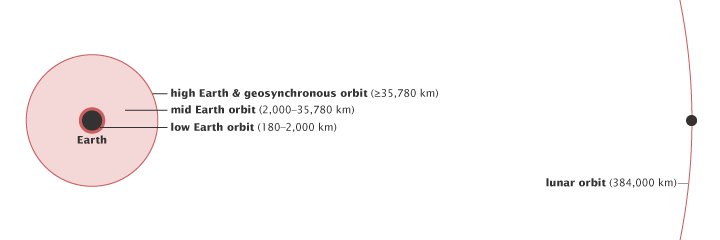
The height of the orbit, or distance between the satellite and Earth’s surface, determines how quickly the satellite moves around the Earth. An Earth-orbiting satellite’s motion is mostly controlled by Earth’s gravity. As satellites get closer to Earth, the pull of gravity gets stronger, and the satellite moves more quickly. NASA’s Aqua satellite, for example, requires about 99 minutes to orbit the Earth at about 705 kilometers up, while a weather satellite about 36,000 kilometers from Earth’s surface takes 23 hours, 56 minutes, and 4 seconds to complete an orbit. At 384,403 kilometers from the center of the Earth, the Moon completes a single orbit in 28 days.
Changing a satellite’s height will also change its orbital speed. This introduces a strange paradox. If a satellite operator wants to increase the satellite’s orbital speed, he can’t simply fire the thrusters to accelerate the satellite. Doing so would boost the orbit (increase the altitude), which would slow the orbital speed. Instead, he must fire the thrusters in a direction opposite to the satellite’s forward motion, an action that on the ground would slow a moving vehicle. This change will push the satellite into a lower orbit, which will increase its forward velocity.
In addition to height, eccentricity and inclination also shape a satellite’s orbit. Eccentricity refers to the shape of the orbit. A satellite with a low eccentricity orbit moves in a near circle around the Earth. An eccentric orbit is elliptical, with the satellite’s distance from Earth changing depending on where it is in its orbit.

Inclination is the angle of the orbit in relation to Earth’s equator. A satellite that orbits directly above the equator has zero inclination. If a satellite orbits from the north pole (geographic, not magnetic) to the south pole, its inclination is 90 degrees.

Together, the satellite’s height, eccentricity, and inclination determine the satellite’s path and what view it will have of Earth.
When a satellite reaches exactly 42,164 kilometers from the center of the Earth (about 36,000 kilometers from Earth’s surface), it enters a sort of “sweet spot” in which its orbit matches Earth’s rotation. Because the satellite orbits at the same speed that the Earth is turning, the satellite seems to stay in place over a single longitude, though it may drift north to south. This special, high Earth orbit is called geosynchronous.
A satellite in a circular geosynchronous orbit directly over the equator (eccentricity and inclination at zero) will have a geostationary orbit that does not move at all relative to the ground. It is always directly over the same place on the Earth’s surface.
A geostationary orbit is extremely valuable for weather monitoring because satellites in this orbit provide a constant view of the same surface area. When you log into your favorite weather web site and look at the satellite view of your hometown, the image you are seeing comes from a satellite in geostationary orbit. Every few minutes, geostationary satellites like the Geostationary Operational Environmental Satellite (GOES) satellites send information about clouds, water vapor, and wind, and this near-constant stream of information serves as the basis for most weather monitoring and forecasting.

Because geostationary satellites are always over a single location, they can also be useful for communication (phones, television, radio). Built and launched by NASA and operated by the National Oceanic and Atmospheric Administration (NOAA), the GOES satellites provide a search and rescue beacon used to help locate ships and airplanes in distress.
Finally, many high Earth orbiting satellites monitor solar activity. The GOES satellites carry a large contingent of “space weather” instruments that take images of the Sun and track magnetic and radiation levels in space around them.
Other orbital “sweet spots,” just beyond high Earth orbit, are the Lagrange points. At the Lagrange points, the pull of gravity from the Earth cancels out the pull of gravity from the Sun. Anything placed at these points will feel equally pulled toward the Earth and the Sun and will revolve with the Earth around the Sun.
Of the five Lagrange points in the Sun-Earth system, only the last two, called L4 and L5, are stable. A satellite at the other three points is like a ball balanced at the peak of a steep hill: any slight perturbation will push the satellite out of the Lagrange point like the ball rolling down the hill. Satellites at these three points need constant adjustments to stay balanced and in place. Satellites at the last two Lagrange points are more like a ball in a bowl: even if perturbed, they return to the Lagrange point.
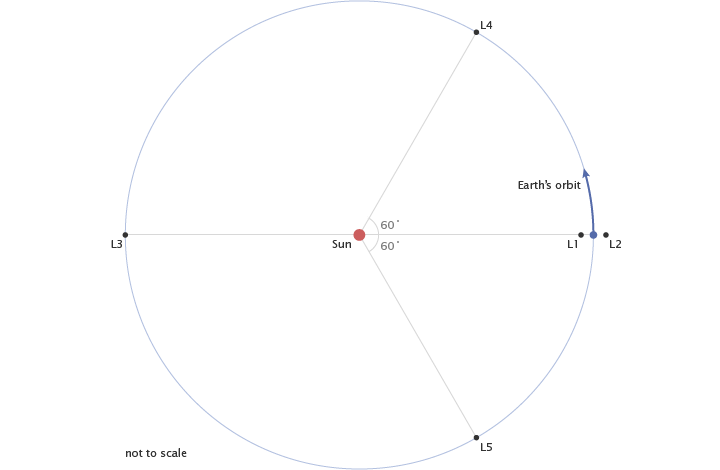

The first Lagrange point is located between the Earth and the Sun, giving satellites at this point a constant view of the Sun. The Solar and Heliospheric Observatory (SOHO), a NASA and European Space Agency satellite tasked to monitor the Sun, orbits the first Lagrange point, about 1.5 million kilometers away from Earth.
The second Lagrange point is about the same distance from the Earth, but is located behind the Earth. Earth is always between the second Lagrange point and the Sun. Since the Sun and Earth are in a single line, satellites at this location only need one heat shield to block heat and light from the Sun and Earth. It is a good location for space telescopes, including the future James Webb Space Telescope (Hubble’s successor, scheduled to launch in 2014) and the current Wilkinson Microwave Anisotropy Probe (WMAP), used for studying the nature of the universe by mapping background microwave radiation.
The third Lagrange point is opposite the Earth on the other side of the Sun so that the Sun is always between it and Earth. A satellite in this position would not be able to communicate with Earth. The extremely stable fourth and fifth Lagrange points are in Earth’s orbital path around the Sun, 60 degrees ahead of and behind Earth. The twin Solar Terrestrial Relations Observatory (STEREO) spacecraft will orbit at the fourth and fifth Lagrange points to provide a three-dimensional view of the Sun.
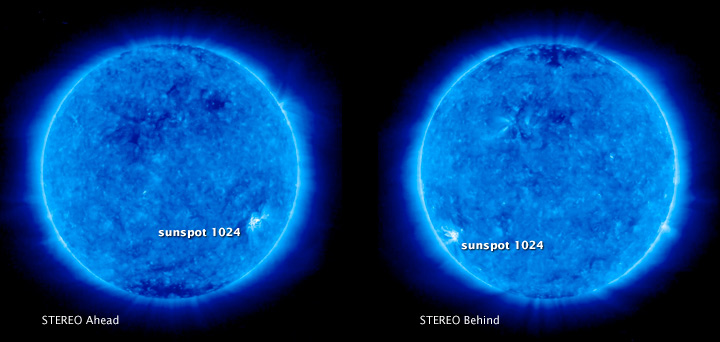
Closer to the Earth, satellites in a medium Earth orbit move more quickly. Two medium Earth orbits are notable: the semi-synchronous orbit and the Molniya orbit.
The semi-synchronous orbit is a near-circular orbit (low eccentricity) 26,560 kilometers from the center of the Earth (about 20,200 kilometers above the surface). A satellite at this height takes 12 hours to complete an orbit. As the satellite moves, the Earth rotates underneath it. In 24-hours, the satellite crosses over the same two spots on the equator every day. This orbit is consistent and highly predictable. It is the orbit used by the Global Positioning System (GPS) satellites.
The second common medium Earth orbit is the Molniya orbit. Invented by the Russians, the Molniya orbit works well for observing high latitudes. A geostationary orbit is valuable for the constant view it provides, but satellites in a geostationary orbit are parked over the equator, so they don’t work well for far northern or southern locations, which are always on the edge of view for a geostationary satellite. The Molniya orbit offers a useful alternative.
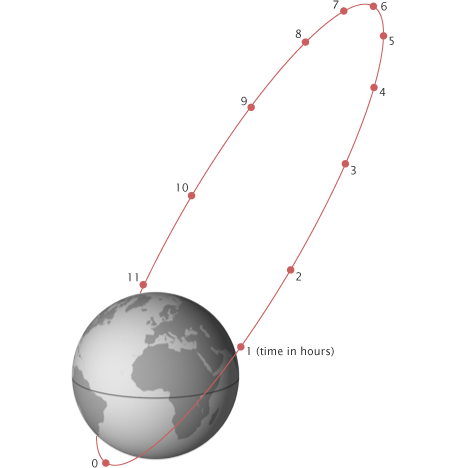
The Molniya orbit is highly eccentric: the satellite moves in an extreme ellipse with the Earth close to one edge. Because it is accelerated by our planet’s gravity, the satellite moves very quickly when it is close to the Earth. As it moves away, its speed slows, so it spends more time at the top of its orbit farthest from the Earth. A satellite in a Molniya orbit takes 12 hours to complete its orbit, but it spends about two-thirds of that time over one hemisphere. Like a semi-synchronous orbit, a satellite in the Molniya orbit passes over the same path every 24 hours. This type of orbit is useful for communications in the far north or south.
Most scientific satellites and many weather satellites are in a nearly circular, low Earth orbit. The satellite’s inclination depends on what the satellite was launched to monitor. The Tropical Rainfall Measuring Mission (TRMM) satellite was launched to monitor rainfall in the tropics. Therefore, it has a relatively low inclination (35 degrees), staying near the equator.
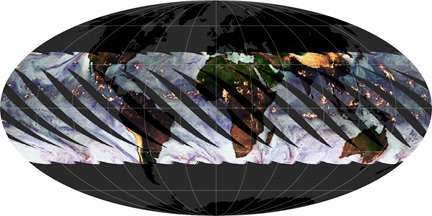
Many of the satellites in NASA’s Earth Observing System have a nearly polar orbit. In this highly inclined orbit, the satellite moves around the Earth from pole to pole, taking about 99 minutes to complete an orbit. During one half of the orbit, the satellite views the daytime side of the Earth. At the pole, satellite crosses over to the nighttime side of Earth.
As the satellites orbit, the Earth turns underneath. By the time the satellite crosses back into daylight, it is over the region adjacent to the area seen in its last orbit. In a 24-hour period, polar orbiting satellites will view most of the Earth twice: once in daylight and once in darkness.
Just as the geosynchronous satellites have a sweet spot over the equator that lets them stay over one spot on Earth, the polar-orbiting satellites have a sweet spot that allows them to stay in one time. This orbit is a Sun-synchronous orbit, which means that whenever and wherever the satellite crosses the equator, the local solar time on the ground is always the same. For the Terra satellite for example, it’s always about 10:30 in the morning when the satellite crosses the equator in Brazil. When the satellite comes around the Earth in its next overpass about 99 minutes later, it crosses over the equator in Ecuador or Colombia at about 10:30 local time.
The Sun-synchronous orbit is necessary for science because it keeps the angle of sunlight on the surface of the Earth as consistent as possible, though the angle will change from season to season. This consistency means that scientists can compare images from the same season over several years without worrying too much about extreme changes in shadows and lighting, which can create illusions of change. Without a Sun-synchronous orbit, it would be very difficult to track change over time. It would be impossible to collect the kind of consistent information required to study climate change.
The path that a satellite has to travel to stay in a Sun-synchronous orbit is very narrow. If a satellite is at a height of 100 kilometers, it must have an orbital inclination of 96 degrees to maintain a Sun-synchronous orbit. Any deviation in height or inclination will take the satellite out of a Sun-synchronous orbit. Since the drag of the atmosphere and the tug of gravity from the Sun and Moon alter a satellite’s orbit, it takes regular adjustments to maintain a satellite in a Sun-synchronous orbit.
The amount of energy required to launch a satellite into orbit depends on the location of the launch site and how high and how inclined the orbit is. Satellites in high Earth orbit require the most energy to reach their destination. Satellites in a highly inclined orbit, such as a polar orbit, take more energy than a satellite that circles the Earth over the equator. A satellite with a low inclination can use the Earth’s rotation to help boost it into orbit. The International Space Station orbits at an inclination of 51.6397 degrees to make it easier for the Space Shuttle and Russian rockets to reach it. A polar-orbiting satellite, on the other hand, gets no help from Earth’s momentum, and so requires more energy to reach the same altitude.
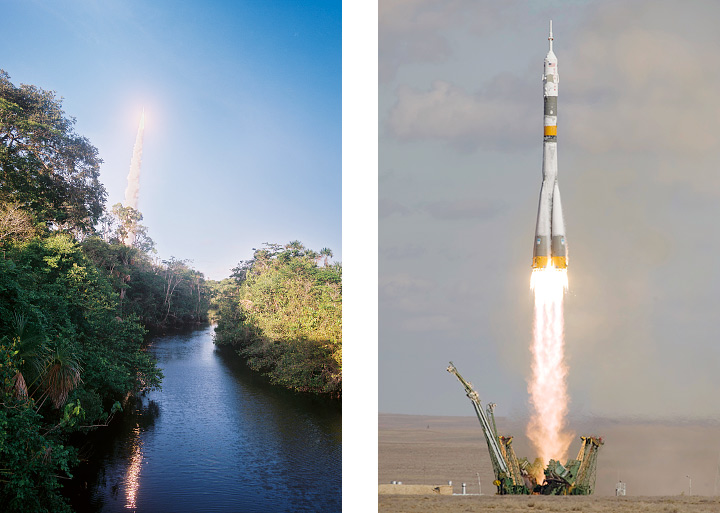
Once a satellite is in orbit, it usually takes some work to keep it there. Since Earth isn’t a perfect sphere, its gravity is stronger in some places compared to others. This unevenness, along with the pull from the Sun, Moon, and Jupiter (the solar system’s most massive planet), will change the inclination of a satellite’s orbit. Throughout their lifetime, GOES satellites have to be moved three or four times to keep them in place. NASA’s low Earth orbit satellites adjust their inclination every year or two to maintain a Sun-synchronous orbit.
Satellites in a low Earth orbit are also pulled out of their orbit by drag from the atmosphere. Though satellites in low Earth orbit travel through the uppermost (thinnest) layers of the atmosphere, air resistance is still strong enough to tug at them, pulling them closer to the Earth. Earth’s gravity then causes the satellites to speed up. Over time, the satellite will eventually burn up as it spirals lower and faster into the atmosphere or it will fall to Earth.
Atmospheric drag is stronger when the Sun is active. Just as the air in a balloon expands and rises when heated, the atmosphere rises and expands when the Sun adds extra energy to it. The thinnest layer of atmosphere rises, and the thicker atmosphere beneath it lifts to take its place. Now, the satellite is moving through this thicker layer of the atmosphere instead of the thin layer it was in when the Sun was less active. Since the satellite moves through denser air at solar maximum, it faces more resistance. When the Sun is quiet, satellites in low Earth orbit have to boost their orbits about four times per year to make up for atmospheric drag. When solar activity is at its greatest, a satellite may have to be maneuvered every 2-3 weeks.
The third reason to move a satellite is to avoid space junk, orbital debris, that may be in its path. On February 11, a communication satellite owned by Iridium, a U.S. company, collided with a non-functioning Russian satellite. Both satellites broke apart, creating a field of debris that contained at least 2,500 pieces. Each piece of debris was added to the database of more than 18,000 manmade objects currently in Earth orbit and tracked by the U.S. Space Surveillance Network.
NASA satellite mission controllers carefully track anything that may enter the path of their satellites. As of May 2009, Earth Observing satellites had been moved three separate times to avoid orbital debris.

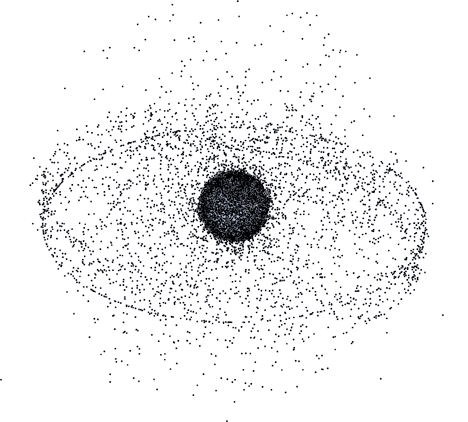
The debris field generated by the Iridium collision is of particular concern to the Earth Observing System because the center of the debris field will eventually drift through the EOS satellites’ orbits. The Iridium and Russian satellites were 790 kilometers above the Earth, while EOS satellites orbit at 705 kilometers. Many pieces of debris from this collision were propelled to lower altitudes and are already causing issues at 705 kilometers.
Mission control engineers track orbital debris and other orbiting satellites that could come into the Earth Observing System’s orbit, and they carefully plan avoidance maneuvers as needed. The same team also plans and executes maneuvers to adjust the satellite’s inclination and height. The team evaluates these planned maneuvers to ensure that they do not bring the EOS satellites into close proximity to catalogued orbital debris or other satellites. To peek in on a day in the mission control center during one such maneuver, see the related article Flying Steady: Mission Control Tunes Up Aqua’s Orbit.